#Michael Pickwoad
Explore tagged Tumblr posts
Text
youtube
youtube
youtube
Oh, a little model of Tardis (from the inside!)
#doctor who#rip michael pickwoad#real artist#tardis#12th doctor#twelfth doctor#bill potts#nardole#peter capaldi#pearl mackie#matt lucas#youtube
17 notes
·
View notes
Text
"TOWARDS ZERO" (2007) Review

"TOWARDS ZERO" (2007) Review
When it comes to the television adaptations of Agatha Christie’s Jane Marple novels, I tend to stick with those that featured the late Joan Hickson as the elderly sleuth. However, my curiosity got the best of me and I decided to watch a movie that starred Geraldine McEwan as Miss Jane Marple. And this movie is the 2007 adaptation of Christie’s 1944 novel called "Towards Zero".
The adaptation of Christie’s novel has drawn a good deal of criticism from purists. First of all, the novel is not a Jane Marple mystery. Instead, the main investigator in "Towards Zero" turned out to be Superintendant Battle, who had been featured in a few other Christie novels, including one Hercule Poirot tale - "Cards on the Table". However, Battle did not appear in the 2007 adaptation. Jane Marple replaced him as the story’s main detective, with the police represented by Alan Davies as one Superintendant Mallard. Since "Towards Zero" has always been one of my favorite Christie novels, I decided to give the movie a chance.
In "TOWARDS ZERO", Jane Marple is invited to a house party hosted by an old school friend named Lady Camilla Tressilian. Also included in the party are the following:
*Neville Strange – Professional tennis star and Lady Tressilian’s ward
*Kay Strange – Neville’s younger second wife
*Audrey Strange - Neville’s reserved ex-wife
*Thomas Royce – Owner of a Malaysian plantation and Audrey’s distant cousin
*Mary Aldin – Lady Tressilian’s companion
*Ted Latimer – Kay’s childhood friend
*Mr. Treves- Lady Tressilian’s friend and solicitor
The house party turned out to be a tense affair, due to emotions running rampant between the characters. Neville discovered that he was still in love with his first wife, Audrey. She seemed to harbor emotions for him, despite her reserved behavior. Thomas seemed jealous of Neville, due to his love for Audrey. Mary seemed attracted to Thomas and a little envious of Audrey. Kay was obviously jealous of Audrey. And Ted was also jealous of Neville, due to his love for Kay.
During a supper party, Mr. Treves recalled an old murder case in which a child had made deliberate preparations to kill another and make it look like an accident. That child, according to Mr. Treves, had a peculiar physical trait. All of the suspects possessed a peculiar physical trait. And following the supper party, Mr. Treves died from a heart attack after climbing some stairs that lead to his hotel room. Someone had placed a NOT IN SERVICE sign in front of his hotel’s elevator. Another day or two later, this same person brutally murdered old Lady Tressilian with a blow to the head.
As I had earlier stated, the 1944 novel has always been a favorite of mine. Christie had crafted a complex and original mystery filled with characters of great psychological depth. By inserting another Christie creation – Jane Marple – as the story’s main investigator, I feared that this 2007 adaptation would prove to be a bust. Imagine my surprise when my fears proved to be groundless. Thanks to director David Grindley and screenwriter Kevin Elyot, I found myself surprisingly satisfied with this movie. Despite a few changes – namely the post-World War II setting, Jane Marple as the story’s main detective, the deletion of a character named Andrew MacWhirter, the addition of another character named Diana, the new police officer in charge of the case – Superintendant Mallard, and the budding romance in the story’s conclusion that did not happen in the novel. Perhaps that is why I had enjoyed it so much. Both Grindley and Elyot recognized the novel’s first-rate plot and tried to follow it as closely as possible.
The production values for "TOWARDS ZERO" impressed me as well. Production designer Michael Pickwoad did an excellent job in re-creating Britain of the early-to-mid 1950s. And he was ably supported by Sue Gibson’s beautiful photography, which struck me as rich in color and sharp. Sheena Napier’s costumes not only captured the era perfectly, but also the personality of each character. I do have one quibble – namely Saffron Burrows’ hairstyle. I am aware that some women wore their hair slightly long past the shoulders. But I got the impression that the hairdresser could not decide whether to give Burrows a 1950s hairstyle or a modern one. Her hair struck me as a confusing mixture of the mid 20th century and the early 21st century.
The cast turned out better than I had expected. If I must be honest, I could not spot a bad performance amongst the entire cast. The whole lot of them - Julian Sands, Paul Nicholls, Julie Graham, Greg Rusedski, Guy Williams, Amelda Brown, Jo Woodcock and especially Tom Baker - gave first-rate performances. But there were a handful that really impressed me. One came from Saffron Burrows, who gave one of the most enigmatic and intense performances I have ever encountered in a Christie film. I could never tell whether her character was guilty of the two murders or not. And Burrows did a superb job in conveying this ambiguity of the Audrey Strange character with very little dialogue. I was also impressed by Zoe Tapper’s portrayal of the more extroverted Kay Strange. Tapper could have easily given an over-the-top performance, considering the type of character she had portrayed. But the actress conveyed Kay’s passionate nature without turning the character into a one-note scream fest. I also enjoyed Alan Davies as Superintendant Mallard, the new police investigator in this mystery. I not only enjoyed his wit, but also his transformation from his contempt toward Jane Marple’s investigative skills to a full partnership with the elderly amateur sleuth. And Eileen Atkins provided a great deal of comic relief as the second victim, Lady Camilla Tressilian. Not only did she provide much of the story’s sharp humor, Atkins also captured the character’s bombastic and arrogant nature. Her Lady Tressilian struck me as a modern day Lady Catherine de Bourgh, but with a stronger moral center.
But I believe the two best performances came from Greg Wise and Geraldine McEwan as Jane Marple. I found myself completely surprised by Wise’s impressive portrayal of the tennis pro with the two wives, Neville Strange. His performance perfectly portrayed Neville as the complex force of nature that had a major impact upon the other characters in "TOWARDS ZERO", without indulging in any hammy acting. But I was more than impressed by Geraldine McEwan’s portrayal of Jane Marple. I had seen McEwan’s portrayal of Miss Marple in "THE SITFORD MYSTERY", and found her performance ridiculously mannered and annoying. No such exaggerated mannerisms marred McEwan’s performance in "TOWARDS ZERO". The actress gave a subtle performance laced with subtle humor and her character’s intelligence. One of McEwan’s best moments featured very little dialogue on her part in a scene between Miss Marple and the verbose Lady Tressilian, inside the latter’s bedroom.
Most Agatha Christie purists might automatically dismiss this adaptation of "TOWARDS ZERO". Especially since the script changed the main investigator from the literary Superintendent Battle to a cinematic Jane Marple. But despite this major change, along with another that included a romance that emerged in the film’s final scene; David Grindley’s direction and Kevin Elyot’s script remained surprisingly faithful to Agatha Christie’s novel. Normally, I would care less about changes in an adaptation of a novel. But in the case of "TOWARDS ZERO", the choices made by Elyot worked in the movie's favor.

#agatha christie#agatha christie's marple#jane marple#towards zero#towards zero 1944#towards zero 2007#geraldine mcewan#eileen atkins#saffron burrows#greg wise#jo woodcock#julian sands#tom baker#paul nicholls#julie graham#zoe tapper#greg rusedski#alan davies
6 notes
·
View notes
Photo
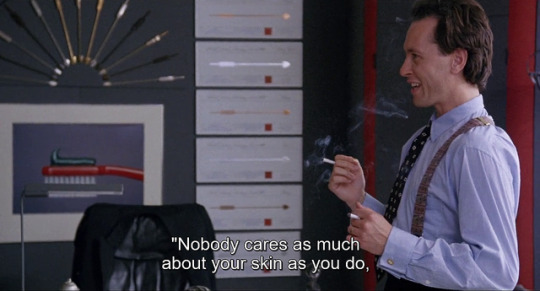
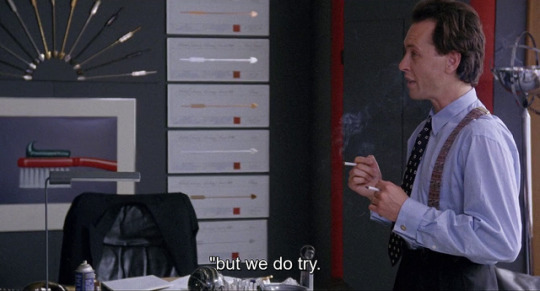
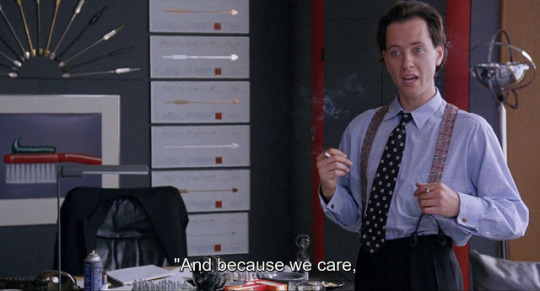
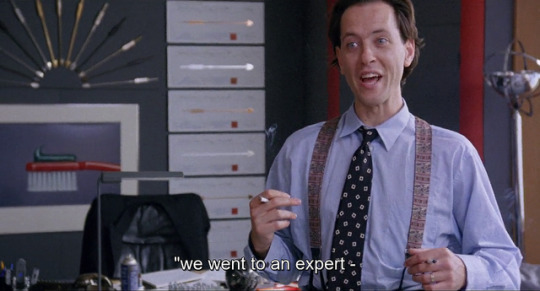
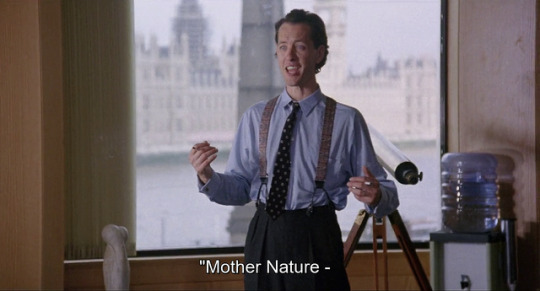
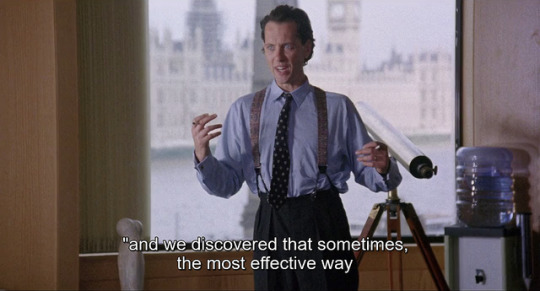
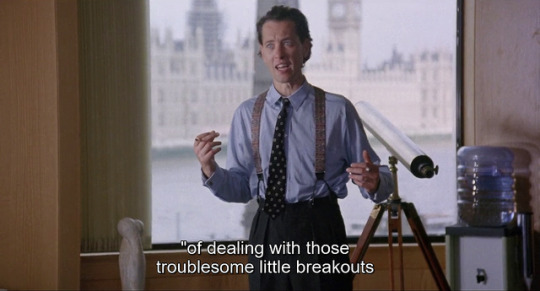
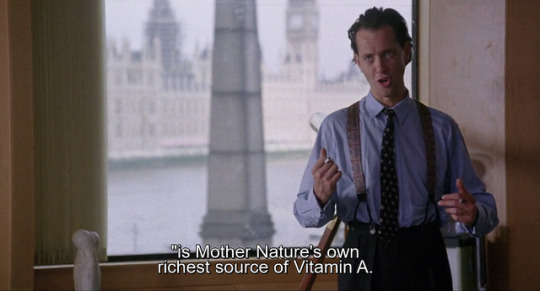
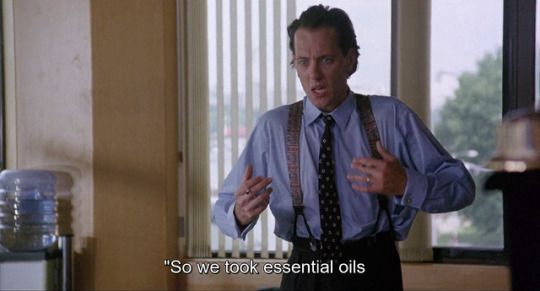
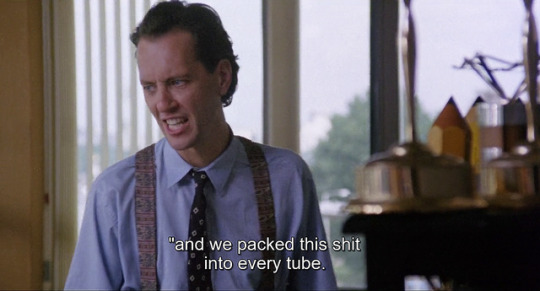
How to Get Ahead in Advertising (Bruce Robinson, 1989).
#how to get ahead in advertising (1989)#bruce robinson#richard e. grant#peter hannan#alan strachan#michael pickwoad#henry harris#Robyn Hamilton-Doney#andrea galer#how to get ahead in advertising
60 notes
·
View notes
Text
Ok so in the back of my mind I knew that the eleventh doctor’s original TARDIS was built on the site of the recently-demolished Torchwood hub set but youtube has been recommending me BTS videos and LOOK! The dragon mural was still there in one corner!!

(side note 1: this is never seen in canon afaik, since this part of the set was never meant to be visible on camera - a new wall was added there in series 7a to make the set 360⁰.)
(side note 2: the guy in the screenshot is the late Michael Pickwoad, production designer from series 6-10. He didn’t design this set, but did design the Eleventh Doctor’s second TARDIS & the updates it got for the Twelfth Doctor, along with Hartnell-style variants in Hell Bent and Twice Upon a Time and all other sets from series 6-10. By all accounts a lovely man and a genius.)
16 notes
·
View notes
Text
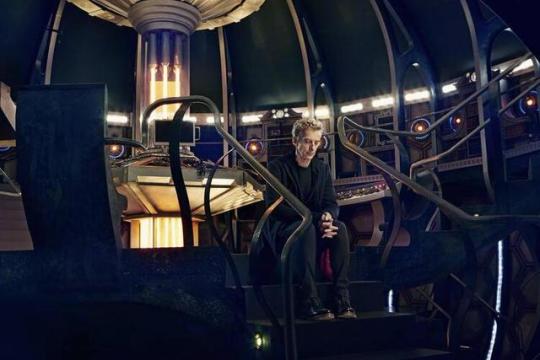
RIP Michael Pickwoad - set designer for Doctor Who 2010-2017.
Picture by Stuart Manning
176 notes
·
View notes
Link
Some lovely words of tribute from Moff after the sad loss of Michael Pickwoad. I still treasure memories of the day back in 2015 when I visited the Tardis set.
Such an incredible structure, and really clever too the way it enabled 360 degree filming, and had several levels, which made it feel far more like a real space ship, rather than a flat TV studio.
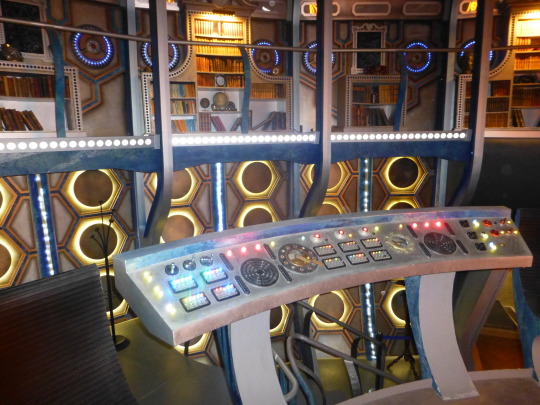
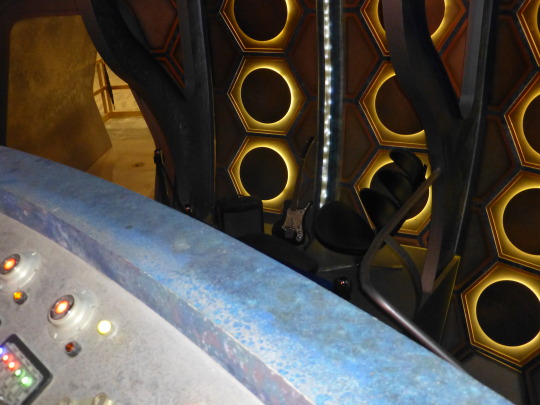
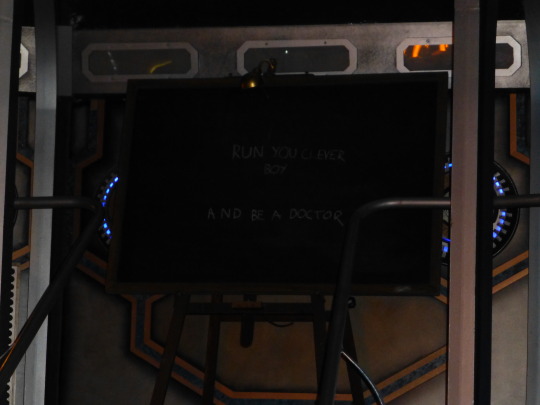
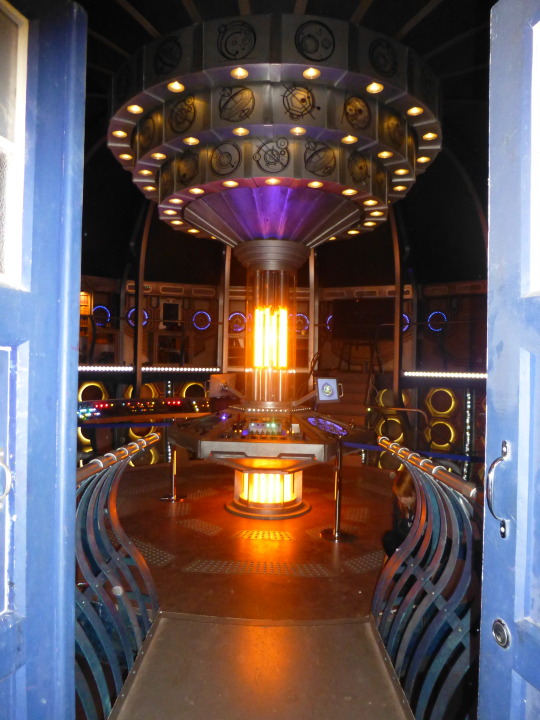
17 notes
·
View notes
Link
2 notes
·
View notes
Text
Do we really have to turn production design in Doctor Who into a RTD v Moffat v Chibnall thing? It should be a Edward Thomas v Michael Pickwoad v Arwel Jones thing since it was actually all their work and at least one of them (Thomas) worked on multiple eras.
#Doctor Who#DW#the show is more than just the guys who run it#it is made by many talented people#and they all don't just get replaced the minute a new boss takes over#Murray Gold was composers for seasons 1-10#Ray Holman did costumes for seasons 5 9 11 and 12#Andy Pryor has been the casting director since Rose#if we're going to debate things other than the writing then at least credit those responsible
7 notes
·
View notes
Text
Some revelations from the Heaven Sent tweet-a-long
Thanks to @chipsandcoffee‘s post here, those of us where were unable to follow the Heaven Sent tweet-a-long got to see some of the highlights. Apparently, Steven Moffat didn’t give the same volume of commentary as he did with his previous event, but director Rachel Talalay gave some great comments. As someone who has lived and breathed the episode (most recently writing a fan fic prequel to it), there were several things that caught my attention and filled in some knowledge gaps (be sure to read the whole post for all of the best ones, I’m just picking a few highlights):
* Although Rachel didn’t provide a name, we now have someone to credit for the Clara portrait: designer Michael Pickwoad’s daughter. A new fan art folk hero is born!
* So Rachel thought “I am in 12″ might have referred to Clara. Interestingly, as we all know, Moffat originally planned to have “I am in 12″ written on the back of Clara’s portrait too. So maybe that was the original idea (and, since breaking through the wall and getting back to Gallifrey to pull Clara out of time was the Doctor’s game plan, I don’t think Rachel’s interpretation is wrong).
* Possibly the biggest surprise - if I understand Rachel correctly - is that some of the images of StormRoom!Clara were not of a body double but were manipulated images of Jenna herself. There are still a couple of moments where Clara had to be have been a double, but still - interesting!
* Maybe someday we’ll see the alternate take where we see Jenna perform Clara’s complete “encouragement” speech on camera. Having read the script as posted to the BBC Writer’s Room website, I know there was one or two extra lines too, so maybe they were filmed too.
I hope they do Hell Bent at some time; I’d love to hear more about the making of that.
#heaven sent#rachel talalay#twelfth doctor#clara oswald#peter capaldi#jenna coleman#doctorwholockdown#hellofabird
22 notes
·
View notes
Text
"DEATH ON THE NILE" (2004) Review
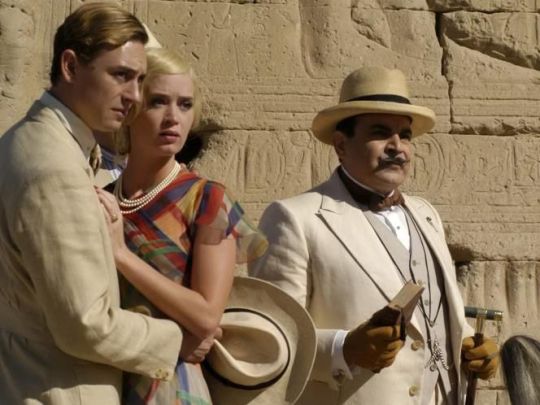
"DEATH ON THE NILE" (2004) Review This 2004 adaptation of Agatha Christie’s 1937 novel, "Death on the Nile", was the second to be adapted for the screen. In the case of this movie, it aired as a 90-minute presentation on the long-running television series, "Agatha Christie’s POIROT".
Like the novel and the 1978 movie adaptation, ”DEATH ON THE NILE” centered around Hercule Poirot’s investigation of the murder of an Anglo-American heiress named Linnet Ridgeway. Linnet had stolen the affections of her best friend’s fiancé and married him. When the newly married couple vacationed in Egypt, the best friend – one Jacqueline de Bellefort – stalked and harassed them during their honeymoon. Yet, when Linnet and her new husband, Simon Doyle, boarded the S.S. Karnak for a steamboat cruise down the Nile River, the heiress discovered she had other enemies that included the offspring of a man whom her father had financially ruined, her embezzling attorney who required her signature on a paper or her death to hide his crimes, a kleptomaniac American socialite and a professional thief who was after her pearls. Unfortunately for the killer, a vacationing Hercule Poirot and his friend, Colonel Race, are on hand to solve Linnet’s murder. There were aspects of this adaptation of "DEATH ON THE NILE" that I found admirable. The movie’s set designs for the S.S. Karnak seemed bigger and slightly more luxuriant that what was shown in the 1978 movie. Production designer Michael Pickwoad did a first-rate job in creating the luxurious atmosphere for the 1930s upper class. Actor J.J. Feild gave a solid performance as Simon Doyle, the man who came between Linnet Ridgeway and Jacqueline de Bellefort. However, I do not think he managed to capture the literary Simon Doyle’s boyish simplicity and lack of intelligence. I also enjoyed Frances La Tour’s portrayal of the alcoholic novelist, Salome Otterbourne. She gave her performance a slight twist in which her character seemed to be a little hot under the collar as she makes sexual advances toward Poirot in a subtle, yet comic manner. And the movie’s one true bright spot was, of course, David Suchet as Hercule Poirot. As usual, he gave an exceptional performance. However, I noticed that he was never able to form any real chemistry with James Fox’s Colonel Race or Emma Griffiths Malin, who portrayed Jacqueline de Bellefort; as Peter Ustinov had done with David Niven and Mia Farrow, respectively. I wish I could harbor a high opinion of "DEATH ON THE NILE". But I cannot. There were too many aspects of this production that rubbed me the wrong way. I noticed that this version adhered closer to Christie’s novel than the 1978 film. Unfortunately, the screenplay’s close adaptation did not help the movie very much. It still failed to be superior or just as good as the 1978 version. So much for the argument that a movie has to closely follow its literary source in order for it to be any good. A closer adaptation of Christie’s novel meant that characters missing from the 1978 version – Cornelia Robson, Marie Van Schuyler’s clumsy young cousin; society jewel thief Tim Allerton; the ladylike Mrs. Allerton and the Allertons’ cousin, Joanna Southwood – appeared in this movie. Only the Italian archeologist, Mr. Richetti and Jim Fanthorp, the British attorney were missing. And honestly, the presence of the Allertons, Cornelia Robson and Joanna Southwood added nothing to the story as far as I am concerned. Aside from a few members of the cast, the acting in this movie struck me as very unexceptional and a little hammy at times. You know . . . the kind of hamminess that makes one wince, instead of chuckle with amusement. There were other aspects that I disliked. Emma Blunt's portrayal of the autocratic Linnet Ridgeway Doyle struck me as . . . well, shallow instead of impressive. I had this feeling that she was simply going through the motions with a Valley Girl's accent. One scene featured her smoking a marijuana joint. Linnet Doyle has never struck me as the type who would risk losing her self control with the use of drugs. There were other performances I did not care for. I found Zoe Talford's Rosalie Otterbourne to be ridiculously arch and sardonic. Nor did I care for Judy Parfitt's one-note portrayal of the autocratic American socialite, Mrs. Marie Van Schyler. I could say the same for Daniel Lapaine's performance as the effiminate Tim Allerton. And Alistair Mackenzie's portrayal of the ardent Communist, Mr. Ferguson, seemed to be all over the map. The movie featured a potential romance between Rosalie Otterbourne and Tim Allerton, which was featured in the novel. Unfortunately, I disliked how screenwriter Kevin Elyot ended it . . . by hinting incestuous tones between Tim and his mother. I found it so unnecessary. Nor was I impressed by director Andy Wilson handling of the Abu Simbel temples sequence in which one of the passengers tried to shove a boulder on Linnet and Simon. It struck me as rather shabby and almost anti-climatic. Blunt's lazy performance in this scene did not help. But the movie’s real atrocities came from the hairstyles and makeup created for the younger actresses in the cast. Most of the hairstyles seemed like sloppy re-creations of those from the mid-1930s, the worst offenders being the cheap-looking blond wig worn by Emily Blunt (Linnet Ridgeway Doyle), the butch hairstyle worn by actress Zoe Telford (Rosalie Otterbourne); and the gaudy makeup worn by all of the younger actresses. Only Daisy Donovan, who portrayed Cornelia Robson was spared from resembling a kewpie doll. Instead, she wore a sloppy bun that served as a metaphor for her insecure personality – a theatrical maneuver that I found unnecessary. I hate to say this but despite David Suchet’s performance as Poirot and Michael Pokewoad’s production designs, I came away feeling less than impressed by this version of "DEATH ON THE NILE". Not only did I find it inferior to the 1978 version, but also to many other adaptations of Agatha Christie’s novels and stories.
#agatha christie#death on the nile#death on the nile 2004#hercule poirot#agatha christie's poirot#david suchet#james fox#zoe talford#frances de la tour#david soul#j.j. feild#judy parfitt#alistair mackenzie#daniel lapaine#barbara flynn#emma griffiths malin#daisy donovan
28 notes
·
View notes
Text
Radio Free Skaro #651 - Shipshape and Bristol Fashion
Radio Free Skaro #651 - Shipshape and Bristol Fashion (Bob Baker and Dave Martin Miniscope, plus Series 11 speculation) #DoctorWho
Sad news this week as legendary production designer Michael Pickwoad passed away at age 73, leaving behind a legion of fans and a body of work that included iconic Doctor Who sets over 71 episodes but spanned a decades-long career in film and television. He will be missed. We also speculate about a likely Sunday start date in October for Series 11, we have news of a Doctor Who fan experience…
View On WordPress
#Big Finish#Bob Baker#Dave Martin#Marketing#Matt Smith#Michael Pickwoad#Miniscope#Obituary#Sheridan Smith#star wars#The Armageddon Factor#The Invisible Enemy#The Nightmare of Eden#Titan Comics#Underworld
0 notes
Note
did you see michael pickwoad has died :( the bbc posted a lovely tribute which has some moving comments from moffat
I saw. There’s nothing I can really say that hasn’t been beautifully said by people who actually worked with him, but it’s certainly very sad news that has been felt throughout the fandom, and I guess it’s lovely that his work lives on in an iconic place in cultural history in tribute.
10 notes
·
View notes
Note
with the passing of michael pickwoad, what are your thoughts on his impact on doctor who versus ed thomas and what arwel wyn jones might bring to the table under chibnall?
It seems straightforwardly true that Pickwoad is the best production designer the show has had since Roger Murray-Leach. There’s simply not a bad production design in his tenure. Thomas is clearly inferior. Dunno Arwel Wyn Jones’s work, but man, you can’t relish having to replace Pickwoad.
5 notes
·
View notes
Text
Michael Pickwoad 1945-2018
Latest from the news site: Michael Pickwoad, the man behind the look of Doctor Who for the last seven years, has died at the age of 73 As Production Designer Michael Pickwoad oversaw the look of the series from Matt Smith's first Christmas story, A Christmas Carol, until the end of the Peter Capaldi era in Twice Upon A Time. He worked on 71 episodes of the series, designing a new TARDIS interior for the Twelfth Doctor, as well as several episodes of the spin off series Class. Born in 1945, Michael Pickwoad was the son of the actor William Mervyn, who appeared in the Doctor Who story The War Machines, and the theatre designer Anne Margaret Payne Cooke. He studied Civil Engineering at Southampton University. He began his career as an Art Director in the early 1970's, working for the Children's Film & Television Foundation on short films such as Wreck Raisers. In the 1980's he moved onto Production Designer, taking responsibility for the overall visual look of a production. One of the first films he worked on was the cult classic Withnail & I, starring Paul McGann His work on TV included Rules of Engagement, Kavanagh QC and Murder Most Horrid, the Dawn French comedy, part of which was co-written by Steven Moffat. He worked with Moffat on his series Coupling and again on his 2007 drama Jekyll. In 2010 he took over as Doctor Who's Production Designer, only the second person to hold the position since the series returned in 2005. His tenure saw him create sets that ranged from Victorian London to the Wild West, from the badlands of Skaro to the wilds of Sherwood Forest, from a Cold War Submarine to the Orient Express in space. Tom Spilsbury, Editor of Doctor Who Magazine throughout his tenure, paid tribute. We often hear about ‘unsung heroes’, and while it would be misleading to say Michael Pickwoad’s genius was completely unsung, his brilliant contributions were a massive part of Doctor Who’s success over the past eight years. His sets were simply extraordinary. A wonderful man. Michael Pickwoad died on Monday 27th August. Michael Pickwoad told BBC News where he got his inspiration for the new look TARDIS Doctor Who News http://www.doctorwhonews.net/2018/08/michael-pickwoad-1945-2018.html?utm_source=dlvr.it&utm_medium=tumblr
1 note
·
View note